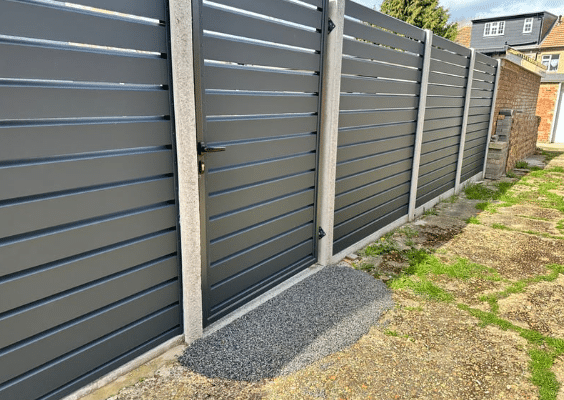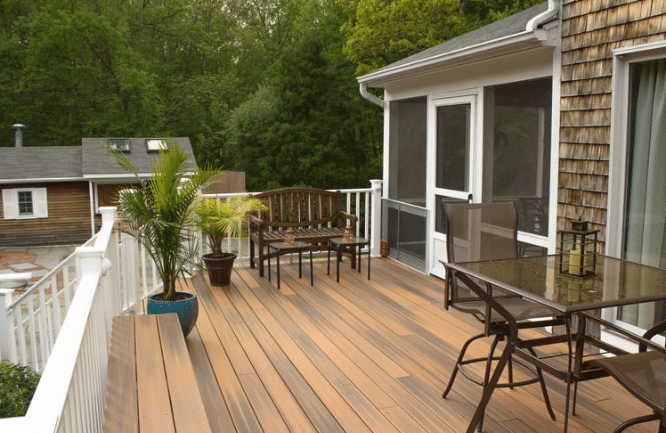Learn how to fix a sagging fence using simple DIY methods and tools you already have. The results will be quick, budget-friendly, and long-lasting!
A sagging fence not only looks bad but also reduces security and privacy. If your fence has started to lean or sag, you can fix it yourself with a few simple tools. This guide will show you how to fix a sagging fence, covering common causes like weather damage, loose posts, and poor installation.

To fix a sagging fence, check the posts for damage, tighten loose screws, replace broken parts, and add concrete or metal brackets for extra support. Realign the panels and secure them firmly to keep the fence straight. If the problem is too big, hire the best fence repair pros near you for a lasting fix.
How to Check for Fence Damage and Fix Sagging
Before fixing a sagging fence, figure out why it’s leaning. This step is important because the right repair depends on the cause. Here are the common reasons for a sagging fence:
1. Rotting or Loose Posts
Fence posts can weaken over time if exposed to moisture or harsh weather. Wooden posts might rot and become unstable, while metal posts can rust or bend, losing their strength. To improve stability and long-term support, replace damaged posts and secure them with concrete.
2. Shifting Ground
Soil movement can make your fence lean or sag. Heavy rain, poor drainage, or tree roots can cause the ground to shift, reducing the stability of the fence posts. Adding gravel, concrete, or compacted soil around the base can help keep your fence upright.
3. Loose Fasteners
Over time, the screws, nails, and brackets holding your fence together can loosen or rust, weakening the overall structure. Regularly check and tighten these fasteners, or replace them if they are too worn, to keep your fence standing straight and secure.
4. Broken Rails
Horizontal rails are important for keeping your fence panels aligned and sturdy. They can crack, warp, or break over time, especially on wooden fences. Replace damaged rails promptly to prevent the fence from leaning and to keep it structurally sound.
5. Wind or Impact Damage
Strong winds or physical impacts, like falling tree branches or accidental bumps, can push your fence out of alignment. Reinforce weak sections with metal braces, stakes, or additional support posts to prevent future sagging and keep your fence in top shape.
How to Reinforce Loose Fence Posts for Long-Lasting Stability
Loose fence posts can weaken the entire structure. Reinforcing them adds stability and extends their life.
1. Clear the Base
Remove dirt, rocks, and debris from around the base of the post. Dig down 6 to 12 inches to expose the lower section. This clears the way for repairs, keeps the post dry, and helps you check for damage, making your fence more stable and secure.
2. Check for Damage

Inspect the exposed post for cracks, rot, or other damage. If the post is too weak, broken, or rotting, it might need replacing. A solid post is important for keeping your fence straight, secure, and stable, reducing the risk of leaning or breaking over time.
3. Add Gravel
Add a layer of gravel around the base of the post. This helps with drainage, keeping water away from the wood, reducing the chance of rot, and improving stability. Gravel also keeps the post steady and adds years to the life of your fence.
4. Set in Concrete
Pour quick-setting concrete around the base of the post. Make sure the post stays straight as the concrete sets. This creates a strong, stable foundation, locking the post, preventing leaning, and adding long-term strength to your fence.
5. Brace While Curing
Use 2×4 braces to hold the post steady while the concrete hardens. This keeps the post from moving or tilting as the concrete sets. Bracing is important for a straight, strong fence that will last for years without leaning or wobbling.
6. Compact the Soil
Once the concrete sets, fill the hole around the post with soil. Compact it tightly to add extra support. This step helps secure the post, reduces the chance of future leaning, and keeps your fence straight and strong for many years.
How to Replace Rotten Fence Posts for Lasting Support
Replacing a rotted fence post is a smart choice for long-term stability. It prevents future leaning and keeps your fence strong and secure. If you’re wondering how to fix a sagging fence, replacing the post is often the best long-term solution.
1. Remove the Old Post

Start by carefully removing the rails and pickets around the old post to avoid damage. Dig around the base to loosen the post. Use a jack or leverage to pull it out if it’s stuck. Clear the hole of debris for a clean installation.
2. Measure and Prepare the New Post
Pick a new post that matches the original height, width, and material for a seamless fit. Measure it accurately to ensure proper alignment. If the post is too long, trim it to the correct height for a precise and secure installation.
3. Set the New Post
Dig a hole three times the width of the post for stability. Add a few inches of gravel at the bottom for drainage to prevent rot. Position the post in the hole, ensure it’s perfectly vertical, then pour concrete to hold it firmly in place.
4. Reattach Rails and Pickets
Reattach the rails and pickets once the concrete sets and the post is secure. Check that everything is aligned and secure to prevent future leaning. This approach helps keep your fence strong, straight, and long-lasting for years.
How to Tighten and Replace Fence Fasteners for a Sturdy Fence
Loose fasteners like nails, screws, or brackets can weaken a fence over time, leading to sagging and reduced stability. Regular tightening and replacement can extend your fence’s lifespan and maintain its strength.
1. Inspect Connections
Check all the joints where the rails, posts, and pickets connect. Look for loose screws, rusty nails, or weak spots that can make the fence wobble. Replace them with rust-resistant screws to prevent future problems and keep the fence strong for years.
2. Replace Bent or Broken Brackets
Check the brackets that hold your fence together. If they are bent, rusty, or broken, they can weaken the fence and cause it to lean. Replace them with stronger, rust-proof brackets or add extra support to keep the fence steady and long-lasting.
3. Use the Right Screws for Wooden Fences
Wooden fences need strong, rust-proof screws to hold up in wet weather. Use exterior-grade screws that can resist rust and stay tight over time. This helps keep your fence sturdy, straight, and less likely to loosen or break as the wood ages.
4. Check Chain-Link Fences for Loose Parts
For chain-link fences, inspect the tension bands, bolts, and ties. Tighten any loose parts and replace rusty pieces to keep the fence strong and secure. Regular checks can prevent sagging and keep the fence looking good for years.
5. Test for Stability
After tightening and replacing screws and brackets, gently push the fence to make sure it doesn’t wobble. This quick test helps confirm that your repairs worked and reduces the risk of future leaning or structural problems.
How to Install a Fence Support Brace for Maximum Strength
Adding a support brace to your fence can improve its stability and prevent sagging. This simple method distributes weight evenly, reducing strain on posts and rails for a longer-lasting fence.
1. Diagonal Braces
Attach a diagonal 2×4 brace from the post to the rail for added support. Use strong, rust-resistant screws to secure it firmly. This brace helps keep the fence straight by spreading the weight evenly and reducing the risk of leaning or sagging.
2. Tension Rods
Install tension rods or turnbuckles along the top and bottom of your wire fence. These rods pull the mesh tight, keeping it straight and reducing sagging. This simple addition helps distribute the weight evenly, making the fence stronger and less likely to bend.
3. Kickboards
Add a horizontal kickboard along the bottom of your fence for extra support. This board helps protect the lower part of the fence from ground-level damage, like moisture or impact, and reduces the chance of sagging, extending the life of your fence.
Maintenance Tips to Prevent Your Fence from Sagging
A well-maintained fence lasts longer and stands stronger. Follow these steps to keep your fence from sagging over time and avoid costly repairs.
1. Apply a Wood Sealant

Use a good-quality wood sealant to protect your wooden fence from moisture, rot, and pests. This coating helps the wood resist weather damage, stay strong, and last longer. It also reduces the chances of warping, cracking, or breaking, keeping your fence sturdy.
2. Use Rust-Resistant Paint
For metal fences, apply rust-resistant paint to prevent corrosion. This special coating keeps the metal strong, stops rust from spreading, and reduces future repairs. It also gives your fence a clean, polished look, making it more durable and long-lasting.
3. Ensure Proper Drainage
Add gravel or crushed stone around the base of your fence posts to improve drainage. This prevents water from pooling, reduces soil erosion, and keeps the posts stable. Proper drainage is key to preventing leaning and extending the life of your fence.
4. Trim Nearby Vegetation
Keep bushes, trees, and vines trimmed away from your fence. Overgrown plants can trap moisture, add weight, and weaken the structure. Regular trimming reduces the risk of sagging and keeps the fence firm and straight for years.
5. Inspect and Tighten Fasteners
Check the screws, nails, and brackets on your fence regularly. Tighten any loose parts and replace rusty pieces to keep the fence secure. This simple maintenance step prevents wobbling and keeps your fence strong, reducing the need for costly repairs later.
When to DIY and When to Call a Professional
Fixing a sagging fence is often a simple DIY task, but severe rot, damaged posts, or structural issues may require professional help. If the wall is shared, coordinate with neighbors. Trust Rolling Gates in Walnut Creek for reliable fence repair for quality service.
For fences near foundations, septic systems, or buried cables, hiring a contractor is safer to avoid costly mistakes. However, many homeowners can handle minor sagging with the right tools and effort. Knowing how to fix a sagging fence empowers you to take action confidently.
FAQs on How to Fix a Sagging Fence
How Do You Support a Sagging Fence?
To support a sagging fence, tighten any loose screws, replace damaged posts, or add braces for extra stability. You can also install metal stakes or wooden supports to reinforce the fence panels and keep them upright, preventing further sagging over time.
How to Fix a Sagging Field Fence?
To fix a sagging field fence, tighten the wires, add new posts, or replace damaged sections. Use tensioning tools to pull the wire tight and secure it to the posts. If the posts are leaning, straighten them or add braces for better support.
How to Fix a Fence That Is Leaning Without Replacing It?
To fix a leaning fence without replacing it, straighten the posts, add braces, or use metal stakes for extra support. Tighten loose screws or nails, and check for rotting or damaged wood that might weaken the structure over time.
How Much Does It Cost to Repair a Sagging Fence?
The cost to repair a sagging fence varies based on the type and extent of the damage. Basic fixes like tightening screws or adding braces can cost around $100, while replacing damaged posts or panels can range from $200 to $500, depending on the materials.
Why Do Fences Sag?
Fences sag due to weather, age, or poor installation. Heavy winds, rain, or shifting soil can weaken the posts, causing the structure to lean or warp. Regular maintenance, like tightening screws and replacing worn parts, can help prevent sagging over time.
Conclusion
If your fence is leaning or sagging, it’s important to fix it quickly. A strong fence keeps your property safe and looking good. A trusted fence contractor can strengthen your fence again, preventing bigger problems in the future.
A straight, sturdy fence not only boosts your home’s curb appeal but also protects your property. Learning how to fix a sagging fence can save money and reduce the need for costly repairs. Tightening loose screws, replacing broken parts, and adding brackets can make a big difference.
For expert help, contact Rolling Gates in Walnut Creek. They have the tools, skills, and experience needed to fix your fence properly, from tightening loose screws to replacing broken parts. Trust them to keep your fence strong, straight, and secure for years.
End Note
If you need a reliable gate service, Rolling Gates in Walnut Creek offers gate repair, intercom systems, and gate openers that secure your property. Check our service areas for fast, local support and expert installations you can trust.
Explore our product gallery for design ideas, and stay updated with our latest tips on our blog. We also provide specialized services in Alameda County. Follow us on Facebook, Instagram, Yelp, and X for updates.
For personalized support, reach out through our contact page. Our team will help you secure your property with the right gate solutions. Choose us for quality, reliability, and excellent customer service.
Rolling Gates
Walnut Creek, CA 94596
888-588-1470





